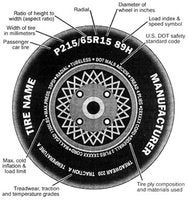tuner forums
3 Answers
The average passenger tire has 3 numbers on it that describe it's size(s). For example my Yaris has P195/50R16 tires on it. The "P" stands for passenger The "195" is the width of the tire in millimeters when measured from side wall to sidewall (if you were looking straight at the tire the sidewall on the left to the right). The "50" is the height of the sidewall as in it is 50% of the width of the tread - in this case 97.5 mm. The "16" is the size of the opening where the wheel goes - in this case 16 inches. I have attached a picture to help
and dont forget the letter at the end of the number thats also important it is the speed rating of the tire this is basically the maximum the speed at which the tire can run before it is in danger of failing go here to a tire speed rating chart: http://en.wikipedia.org/wiki/Tire_code#Speed_rating my tires (Yokohama Parada Spec II) are 215 35ZR18 84W so they can run safely up to 168 mph (270 km/h)
One thing that's most always left unaddressed when it comes to tire sizing and such is the load capacity of the tire. When considering replacing the tires on your daily driver, make sure they meet the factory specs, INCLUDING load rating. Cheap tires may not meet the standard and can prematurely fail. You get what you pay for. Another concern is when upgrading to lower profile, higher performance tires. Lets say you plan on putting a set of 22 inch wheels on a full-size truck. The tires you wrap around those rims may handle incredibly but they won't last long if the load rating is meant for a passenger car. It can potentially be very dangerous.
